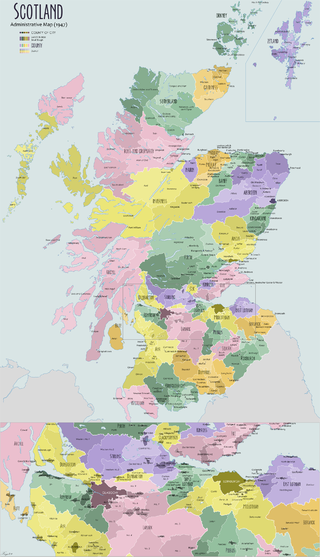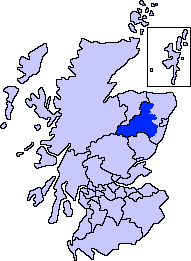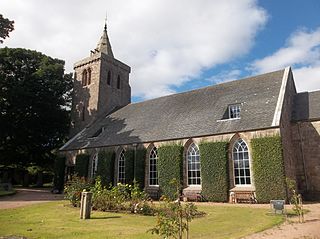Related Research Articles

The Shires of Scotland, or Counties of Scotland, were historic subdivisions of Scotland.

Atholl or Athole is a large historical division in the Scottish Highlands, bordering Marr, Gowrie, Perth, Strathearn, Breadalbane, Lochaber, and Badenoch. Historically it was a Pictish kingdom, becoming one of the original provinces of the Kingdom of Alba before being incorporated into the sheriffdom and later county of Perthshire. Today it forms the northern part of Perth and Kinross, Scotland.

Crail is a former royal burgh, parish and community council area in the East Neuk of Fife, Scotland.

Marr is one of six committee areas in Aberdeenshire, Scotland. It has a population of 34,038. Someone from Marr is called a Màrnach in Scottish Gaelic.

Menteith or Monteith, a district of south Perthshire, Scotland, roughly comprises the territory between the Teith and the Forth. Earlier forms of its name include Meneted, Maneteth and Meneteth.

A sheriff court is the principal local civil and criminal court in Scotland, with exclusive jurisdiction over all civil cases with a monetary value up to £100,000, and with the jurisdiction to hear any criminal case except treason, murder, and rape, which are in the exclusive jurisdiction of the High Court of Justiciary. Though the sheriff courts have concurrent jurisdiction with the High Court over armed robbery, drug trafficking, and sexual offences involving children, the vast majority of these cases are heard by the High Court. Each court serves a sheriff court district within one of the six sheriffdoms of Scotland. Each sheriff court is presided over by a sheriff, who is a legally qualified judge, and part of the judiciary of Scotland.

District courts are a category of courts which exists in several nations, some call them "small case court" usually as the lowest level of the hierarchy.

In Scotland a sheriff principal is a judge in charge of a sheriffdom with judicial, quasi-judicial, and administrative responsibilities. Sheriffs principal have been part of the judiciary of Scotland since the 11th century. Sheriffs principal were originally appointed by the monarch of Scotland, and evolved into a heritable jurisdiction before appointment was again vested in the Crown and the monarch of the United Kingdom following the passage of the Heritable Jurisdictions (Scotland) Act 1746.

A sheriffdom is a judicial district in Scotland, led by a sheriff principal. Since 1 January 1975, there have been six sheriffdoms. Each sheriffdom is divided into a series of sheriff court districts, and each sheriff court is presided over by a resident or floating sheriff. Sheriffs principal and resident or floating sheriffs are all members of the judiciary of Scotland.

The history of local government in Scotland is a complex tale of largely ancient and long established Scottish political units being replaced after the mid 20th century by a frequently changing series of different local government arrangements.

A justice of the peace court is the lowest authoritative type of criminal court in Scotland. The court operates under summary procedure and deals primarily with less serious criminal offences.
A sheriffdom is a judicial district of Scotland. Originally identical to the Shires of Scotland, from the eighteenth century many counties were grouped to form "sheriffdoms".
Before the Acts of Union 1707, the barons of the shire of Fife elected commissioners to represent them in the Parliament of Scotland and in the Convention of the Estates. The number of commissioners was increased from two to four in 1690.
The Sheriff of Caithness was historically the royal official responsible for enforcing law and order in Caithness, Scotland.
The Sheriff Principal of Glasgow and Strathkelvin is the head of the judicial system of the sheriffdom of Glasgow and Strathkelvin, one of the six sheriffdoms covering the whole of Scotland. The current sheriffdoms were created in 1975 to replace the previous arrangement of 12 sheriffdoms. The sheriffdom of Glasgow and Strathkelvin maintains a single Sheriff Court based in Glasgow.
The Sheriff Principal of South Strathclyde, Dumfries and Galloway is the head of the judicial system of the sheriffdom of South Strathclyde, Dumfries and Galloway, one of the six sheriffdoms covering the whole of Scotland. The sheriffdom employs a number of legally qualified sheriffs who are responsible for the hearing of cases in five Sheriffs Court based in Airdrie, Ayr, Dumfries, Hamilton, Lanark and Stranraer. The current sheriffdoms were created in 1975 when the previous arrangement of 12 sheriffdoms was discontinued.
The Sheriff Principal of Tayside, Central and Fife is the head of the judicial system of the sheriffdom of Tayside, Central and Fife, one of the six sheriffdoms covering the whole of Scotland. The sheriffdom employs a number of legally qualified sheriffs who are responsible for the hearing of cases in eight Sheriffs Courts held in Alloa, Dundee, Dunfermline, Falkirk, Forfar, Kirkcaldy, Perth, and Stirling. The current Scottish sheriffdoms were created in 1975 when the previous arrangement of 12 sheriffdoms was discontinued.
The Sheriff Principal of Grampian, Highland and Islands is the head of the judicial system of the sheriffdom of Grampian, Highland and Islands, one of the six sheriffdoms covering the whole of Scotland. The sheriffdom employs a number of legally qualified sheriffs who are responsible for the hearing of cases in thirteen Sheriffs Courts based in Aberdeen, Banff, Elgin, Fort William, Inverness, Kirkwall, Lerwick, Lochmaddy, Peterhead, Portree, Stornoway, Tain and Wick. The current Scottish sheriffdoms were created in 1975 when the previous arrangement of 12 sheriffdoms was discontinued.
The Sheriff Principal of Lothian and Borders is the head of the judicial system of the sheriffdom of Lothian and Borders, one of the six sheriffdoms covering the whole of Scotland. The sheriffdom employs a number of legally qualified sheriffs who are responsible for the hearing of cases in four Sheriffs Courts based in Edinburgh, Jedburgh, Livingston and Selkirk. The current Scottish sheriffdoms were created in 1975 when the previous arrangement of 12 sheriffdoms was discontinued.

Crail Parish Church is an ancient church building in Crail, Fife, Scotland. It is Category A listed, its oldest part dating to the 12th century. The walls and gravestones of its kirkyard are also Category A listed.
References
- Taylor, Alice; The Shape of the State in Medieval Scotland, 1124-1290 (2016).